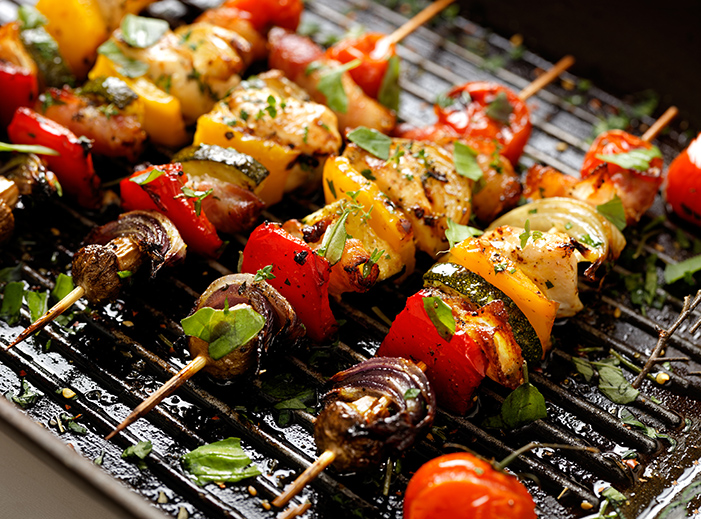Notice of privacy incident at Brigham and Women's Faulkner Hospital Learn More
Header Skipped.
Notice of privacy incident at Brigham and Women's Faulkner Hospital Learn More
Header Skipped.

“Grilling is a great way to make low-fat, healthy and tasty meals that involve minimal clean up,” says Claire LeBrun, MPH, RDN, LDN, Senior Dietitian with the Center for Weight Management and Wellness at Brigham and Women’s Faulkner Hospital.
Whether you’re looking to make healthier meals, or just tired of burgers and dogs, LeBrun offers some of her best advice for making the most of your backyard cooking.
Boneless fish, chicken or pork tenderloin (yes, the latter is just as lean as chicken breast!) are more healthy options than beef, hot dogs and sausage because they are low in saturated fat. Fish, in particular, has a healthy mix of fats including omega-3 fatty acids which helps prevent stroke, promotes heart health and improves brain function as we age. It is also a great source of protein, iodine and vitamin D.
If the fish you like is flaky, you may want to grill it in foil to ensure it does not fall through the grates. Add chopped or thin sliced aromatic vegetables like garlic, leeks, onions, tomatoes and bell peppers and consider adding citrus juice, wine or vinegar as well as spices to infuse lots of flavor while keeping it moist and delicate.
“A firm and flavorful fish that I love is salmon,” says LeBrun. “I usually try and buy a pound or so of the filet and then slice it into four portions to ensure even cooking. It’s best cooked skin side down on the grill, brushed or sprayed with a little oil of your choice (to keep it from sticking) and seasoned with garlic and onion powder, paprika, red pepper and a little salt and pepper. The skin gets crispy and tasty but can also be more easily removed once cooked for those who do not care for it.”
For boneless, skinless chicken breast or pork tenderloin, sometimes the simplest marinade is your favorite salad dressing, but otherwise dry spices are best as they are less likely to drip and cause high flame and infuse more flavor. LeBrun advises spraying or brushing the grates with oil to ensure your protein does not stick. If you are using a marinade with sugar, honey or maple syrup (like barbeque sauce), it’s best not to add it until the last 5 to 6 minutes of cooking to prevent burning. “Speaking of timing, boneless chicken and fish only need 9 to 10 minutes per inch cooking time (4 to 5 minutes per side) or until the thermometer reaches 165 degrees F,” says LeBrun. “Pork tenderloin needs to reach a minimum 145 degrees F internally according to the FDA and should rest at least 3 minutes before slicing. This will provide a medium (slightly pink in center) cooked meat.”
LeBrun suggests trying vegetarian meat alternatives like the Impossible Burger or Beyond Meat which are lower in calories and fat than beef burgers but still high in protein. “For the Impossible Burgers, cook them on high for 2 to 3 minutes per side. It’s OK if they are pink in the middle as there’s no risk of food poisoning and you do not want to dry them out,” say LeBrun. “For the Beyond Burger, grill them on medium flame for 4 minutes per side or to an internal temperature of 165 degrees F.”
“Instead of high fat, high carb sides like pasta and potato salad, just throw your favorite vegetables on the grill,” says LeBrun. “The trick is to cut them into same size pieces to cook evenly, and the larger the better to keep them from falling through the grill.” Brush or spray them with a healthy oil like olive or canola oil first to prevent sticking and drying out. With smaller cut vegetables, try stringing them on a skewer or use a grill basket. Veggies that are good on the grill include asparagus, bell peppers, eggplant, mushrooms, onions, squash and zucchini.
To flavor your vegetables, add salt, pepper and oil spray before grilling and then brush them with a little balsamic glaze a few minutes before the end of their cooking. Most non-starchy vegetables, like the ones listed above, take about 4 to 8 minutes per side at medium to high heat. “A balsamic glaze adds a simple tart and sweet flavor that can’t be beat by more elaborate marinades, in my experience,” says LeBrun.
Want to learn more about healthy eating? Contact the Center for Weight Management and Wellness at Brigham and Women’s Faulkner Hospital at 617-525-3597 to set up an appointment with a registered dietitian.
Published 6/29/22
Looking for more news from BWFH? Go to News to find articles about health, updates to our programs and services and stories about staff and patients.
Go to News